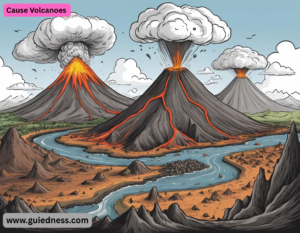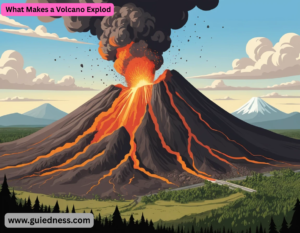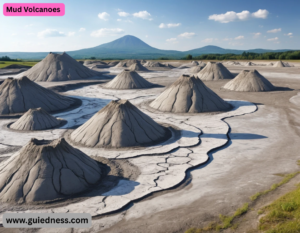Cause Volcanoes Volcanoes are caused by the movement of molten rock (magma) from beneath the Earth’s crust to the surface. This process is driven by plate tectonics, mantle dynamics, and other geological forces. Here’s a breakdown of the main causes:

Plate Tectonics (Primary Cause)
- Divergent Boundaries: Where plates pull apart (e.g., mid-ocean ridges), magma rises to fill the gap, creating underwater volcanoes.
- Convergent Boundaries: Where plates collide, one plate is forced beneath another (subduction). Water from the sinking plate lowers the melting point of the mantle, generating magma (e.g., the Ring of Fire).
- Hotspots: Fixed plumes of hot mantle material rise independently of plate boundaries, melting crustal rock (e.g., Hawaii, Yellowstone).
Mantle Plumes & Hotspots
- Some volcanoes (like Hawaii) form over mantle plumes—columns of extra-hot rock rising from deep in the mantle. These can melt crustal rock even far from plate edges.
Rifting & Continental Breakup
- Stretching of continental crust (e.g., East African Rift) thins the lithosphere, allowing magma to rise.
Other Triggers
- Decompression Melting: Reduced pressure on hot mantle rock (e.g., at divergent boundaries) lets it melt without added heat.
- Flux Melting: Water and gases from subducted plates reduce the melting point of surrounding rock.
Key Result: Eruption
- When magma (now called lava) reaches the surface, it erupts due to pressure from trapped gases (like CO₂ and water vapor).
Plate Tectonics: The Engine of Volcanism
- Volcanoes are primarily a result of Earth’s lithosphere (the rigid outer shell) being broken into tectonic plates that move over the asthenosphere (a semi-fluid layer of the mantle).
Subduction Zones (Explosive Volcanoes)
- How it works: When an oceanic plate collides with a continental plate (or another oceanic plate), it sinks (subducts) into the mantle.
Why magma forms:
- Water trapped in the subducting plate is released, lowering the melting point of the overlying mantle rock (flux melting).
- The melted rock (now magma) rises because it’s less dense than surrounding rock.
- Result: High-silica, gas-rich magma → explosive eruptions (e.g., Mount St. Helens, Krakatoa).
Divergent Boundaries (Effusive Volcanoes)
- Where it happens: Mid-ocean ridges (e.g., Mid-Atlantic Ridge) and continental rifts (e.g., East African Rift).
Why magma forms:
- Magma (low-silica, basaltic) rises to fill the gap.
- Result: Gentle lava flows (shield volcanoes) or underwater pillow lavas.
- Hotspot Volcanism (Independent of Plate Boundaries)
- Hawaii (oceanic hotspot) – forms shield volcanoes.
- Yellowstone (continental hotspot) – can produce supervolcanic eruptions.
Magma Formation: Why Does Rock Melt?
- Three main mechanisms melt solid mantle rock into magma:
- Decompression Melting (at divergent boundaries & hotspots)
- Process: Reduced pressure lowers the melting point of mantle rock.
- Analogy: Like opening a soda bottle—releasing pressure lets bubbles (magma) form.
Flux Melting (at subduction zones)
- Process: Water & CO₂ from the subducting plate act like “salt on ice,” making rock melt at lower temps.
- Heat Transfer Melting (near magma chambers)
- Process: Hot magma rising heats surrounding rocks until they melt.
What Makes a Volcano Explode
The explosiveness depends on:
- Cause Volcanoes Silica Content: High silica (rhyolitic magma) = thick, sticky lava → traps gases → violent eruptions.
- Gas Content: More dissolved H₂O & CO₂ = bigger explosions (like shaking a soda can).
- Magma Viscosity: Runny basalt (low silica) = gentle flows (Hawaii). Thick magma = pyroclastic blasts (Vesuvius).

Types of Volcanoes & Eruptions
- Type Formation Cause Eruption Style Example
Shield Hotspots / Divergent Effusive (lava flows) Mauna Loa (Hawaii)
Stratovolcano Subduction Zones Explosive + lava Mount Fuji (Japan)
Cinder Cone Small magma vents Short, violent bursts Parícutin (Mexico)
Caldera Massive magma chamber collapse Super-eruption Yellowstone (USA)
Unusual Causes of Volcanism
- Flood Basalts: Giant lava flows from large igneous provinces (possibly from super-plumes), e.g., Deccan Traps (India).
- Cryovolcanism: On icy moons (like Saturn’s Enceladus), “volcanoes” erupt water/ammonia instead of lava!
- The Deep Earth: Where Magma is Born
Earth’s Internal Structure & Heat Sources
Earth’s heat comes from:
- Primordial heat (leftover from planetary formation, ~20%)
- Radioactive decay (K-40, U-238, Th-232 in the mantle, ~80%)
- This heat keeps the mantle partially molten (only ~1-10% melt at any time), allowing convection currents that drive plate tectonics.
. The Asthenosphere: The Magma Factory
- Located in the upper mantle (100-660 km deep).
- Not fully liquid! Instead, it’s ductile solid rock with localized melt zones.
Magma forms when:
- Temperature rises (hotspot plumes).
- Pressure drops (divergent boundaries).
- Water is added (subduction zones).
The Physics & Chemistry of Melting Rocks
- How Rocks Melt: The Phase Diagram
- Cause Volcanoes Rocks are solid solutions of minerals (olivine, pyroxene, feldspar).
Their melting depends on:
- Temperature (higher = melt).
- Pressure (higher = harder to melt).
- Composition (wet vs. dry rocks).
Three Ways to Melt the Mantle:
- Decompression Melting (Mid-Ocean Ridges, Hotspots)
- As mantle rises, pressure drops → melting begins at ~60-150 km depth.
- Produces basaltic magma (low silica, runny lava).
Flux Melting (Subduction Zones)
- Water from subducting oceanic crust lowers melting point by ~200°C.
- Produces andesitic/rhyolitic magma (high silica, explosive).
Heat Transfer Melting (Magma Intrusions)
- Hot magma rising heats crustal rocks → partial melting.
- Common in continental rifts (e.g., Yellowstone).
Magma Differentiation: Why Eruptions Vary
- Example: Basalt → Andesite → Dacite → Rhyolite.
- Assimilation: Magma melts surrounding rock, altering chemistry.
- Mixing: Two magma bodies blend, triggering eruptions.
Volcano Types & Eruption Styles
- Effusive (Non-Explosive) Eruptions
- Shield Volcanoes (Hawaii, Iceland)
- Low-silica basalt → gentle lava flows.
- Built over hotspots or divergent boundaries.
- Fissure Eruptions (Flood Basalts)
- Giant lava flows covering thousands of km² (Deccan Traps, Siberian Traps).
Explosive Eruptions
- Stratovolcanoes (Composite Volcanoes)
- High-silica magma + gas → Plinian eruptions (e.g., Vesuvius, Mt. St. Helens).
- Produce pyroclastic flows (600°C, 200+ mph avalanches).
Calderas (Supervolcanoes)
- Exotic Volcanism
- Cryovolcanoes (Ice Moons)
- Erupt water/ammonia/methane (Enceladus, Europa).
Mud Volcanoes
- Not magma-driven—caused by gas & sediment eruptions.
- Catastrophic Volcanism in Earth’s History
A. Mass Extinctions Linked to Volcanism
Siberian Traps (252 Mya) - Largest known volcanic event → Permian-Triassic extinction (90% life wiped out).
- Released CO₂, SO₂, methane → global warming + acid rain.
- Cause Volcanoes Deccan Traps (66 Mya)
- Contributed to dinosaur extinction alongside Chicxulub asteroid.

Supervolcanoes: Civilization-Ending Threats
- Yellowstone (last eruption: 640,000 years ago)
- Would eject 1,000+ km³ of ash → global cooling (“volcanic winter”).
Toba (74,000 years ago)
- Nearly wiped out humans (bottleneck effect).
- Modern Monitoring & Future Predictions
How Scientists Predict Eruptions
- Seismic Activity (earthquake swarms).
- Ground Deformation (GPS, InSAR satellite data).
Gas Emissions (SO₂, CO₂ spikes).
- Thermal Imaging (heat changes at vents).
The Next Big Eruption?
Most Likely Candidates:
- Cause Volcanoes Popocatépetl (Mexico) – Active stratovolcano near Mexico City.
- Campi Flegrei (Italy) – Supervolcano under Naples.
- Taupō (New Zealand) – Similar to Yellowstone.
Beyond Earth: Volcanoes in the Solar System
- Mars: Olympus Mons (tallest volcano, extinct).
- Venus: Thousands of volcanoes (possibly still active).
- Quantum Magma: The Subatomic Origins of Melting
Why Do Rocks Melt? (The Atomic Answer)
- At the atomic level, melting occurs when thermal vibration overcomes lattice bonds in minerals.
- Silicate Minerals (e.g., olivine, quartz) are polymerized networks of SiO₄ tetrahedra.
……….Cause Volcanoes……….



